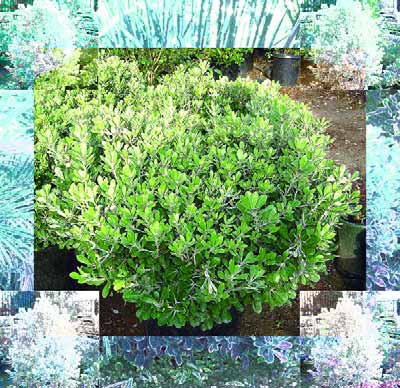plant selection
I've always believed that if you're going to do something, you should do it so well that the results are beyond compare. That basic philosophy has guided our company, GCS of Woodbridge, Calif., from the very start. It has led us to apply the highest standards to every one of our projects, all of which have been executed on large estates for ambitious, affluent, selective clients who invariably want something no one else has. We've been selective from the start as well, seeking clients who are in the process of creating the homes of their dreams and who want to have fun with (and in) their exterior spaces. In most cases, what they want are true oases - resort-like settings that give them a taste of
I've always believed that if you're going to do something, you should do it so well that the results are beyond compare. That basic philosophy has guided our company, GCS of Woodbridge, Calif., from the very start. It has led us to apply the highest standards to every one of our projects, all of which have been executed on large estates for ambitious, affluent, selective clients who invariably want something no one else has. We've been selective from the start as well, seeking clients who are in the process of creating the homes of their dreams and who want to have fun with (and in) their exterior spaces. In most cases, what they want are true oases - resort-like settings that give them a taste of
The fact that the vast majority of our landscapes exist on the ground floor has posed a challenge as city dwelling has become more popular: Relatively few urbanites are lucky enough to have ground-floor garden spaces to work with, but that in no way diminishes their desire to include garden spaces as components of their upper-floor environments. Even without land for plants, people still want to come home to attractive gardens at day's end. Although the first roof gardens date back to the Hanging Gardens of Babylon, city dwellers with only rooftop and balcony spaces at their disposal have been forced to get innovative, developing creative and sometimes highly unusual solutions. Hence the emergence of "roof gardens," which often combine spectacular distant views and dramatic cityscapes with creative hardscape and planting treatments - works of art that expand livable space as well as the
With greater force than ever before, water conservation is back on the minds of governments, landscape professionals and property owners these days - and for good reason: The combination of growing demand and recurring periods of drought has sensitized people in many parts of the country to the fact that water isn't an infinite resource. Even this new magazine is part of the dialogue: In the September/October 2006 issue of LandShapes, James Minnich defined the need for landshapers to become more
We live in a multi-dimensional world. Most people understand that space has three dimensions: height, width and depth. But relatively few people look at color in the same way - that is, as a three dimensional phenomenon. Understanding these three dimensions of color can become the key to unlocking your creativity as a designer. We began our study of color in LandShapes' May/June issue ("Designing in Color," click here), where we explored the scientific nature of color and its first dimension - hue, the name of a color (red, yellow, blue, orange, green or violet) - and learned that each hue has a temperature range (from warm to cool). We also learned that all six hues may be organized and better understood through the use of a helpful tool developed by color scientists called the color wheel. We will now continue our study of color by exploring the second and third dimensions of color and then by discussing contrast, analogous and complementary colors and color harmony. This will enable us to begin applying these fundamentals as landshapers and see in practical terms how understanding these fundamentals can help us become better
It has always bothered me a bit that designers tend to restrict their thinking to just the physical area that fits the definition of their design specialty. Landscape designers stick to outdoor spaces and interior designers work on interior ones - and seldom the twain shall meet. To my way of thinking, that's shortsighted - which is just one of the reasons I'm both a landscape designer and an interior designer. I would argue that, when it is appropriate, professionals on both sides of the divide need to open their eyes and work with the visual flow through and between clients' interior and exterior spaces to achieve optimal design results. As landscape professionals, we already accept the importance of the "borrowed view," a wonderful term used to describe the deliberate capturing of other properties' assets by creating living or artificial frameworks that make them an artistic component of our clients' landscapes. If we are good at capturing neighboring views for our landscapes, I'd suggest it's a short step to make certain that we achieve the same sorts of wonderful views between the
As designers, we learn to evaluate landscapes and watershapes with critical eyes, deciding if we like a plant palette, for example, or if a hardscape makes sense or a watershape is sited properly in a yard. These critical skills are important, because clients hire us to pull all of those elements together and develop solutions that suit their needs as well as those of the setting. On rare occasions, a design/build project will stay on a straight course from initial concept to execution. Usually, however, I know that any ideas or biases I carry onto a job site will change and become more complex as I get to know my clients' wants, needs and desires. In other words, my critical skill - my designer's point of view - is consistently
When I paint, I constantly play with color on canvas and experiment with various combinations to see what works well and discover what, to my eye, clashes or doesn't seem to mix harmoniously. As a landscape designer, I'm aware of working through the same sort of process when I discuss color with clients - determining their likes and dislikes and narrowing the color palette down to those hues, values and intensities that are most appealing to them. Some aren't even aware until I launch into a discussion with them that they have particular tastes involving the color wheel. In my experience, all these clients lean
As landscape professionals, most of us seek not only to innovate and drive the industry to new levels, but also endeavor as necessary to learn about basic design principles and styles that have inspired and ignited design movements in past centuries. By studying the range of architectural and landscape styles that have gone before us, we learn to use historical cues to guide us in our current tasks. At the same time, our knowledge of what was done in the past positions us to develop variations on themes and do things
In looking back over several recent projects, I noticed that I've been using one particular genus of plants more frequently than just about any other. Its name probably evokes thoughts of petri dishes and bacterial colonies for most of us, but this plant genus - Pittosporum - has truly held an extremely valuable position in most of my plant palettes in recent years and is one of the most useful of all plant types I use. I find myself pointing them out every time I take clients to a nursery to view and select plants, and it seems I'm always trying to find ways to fit one or more of its many varieties into my planting plans. I treasure them for their great variety in





















